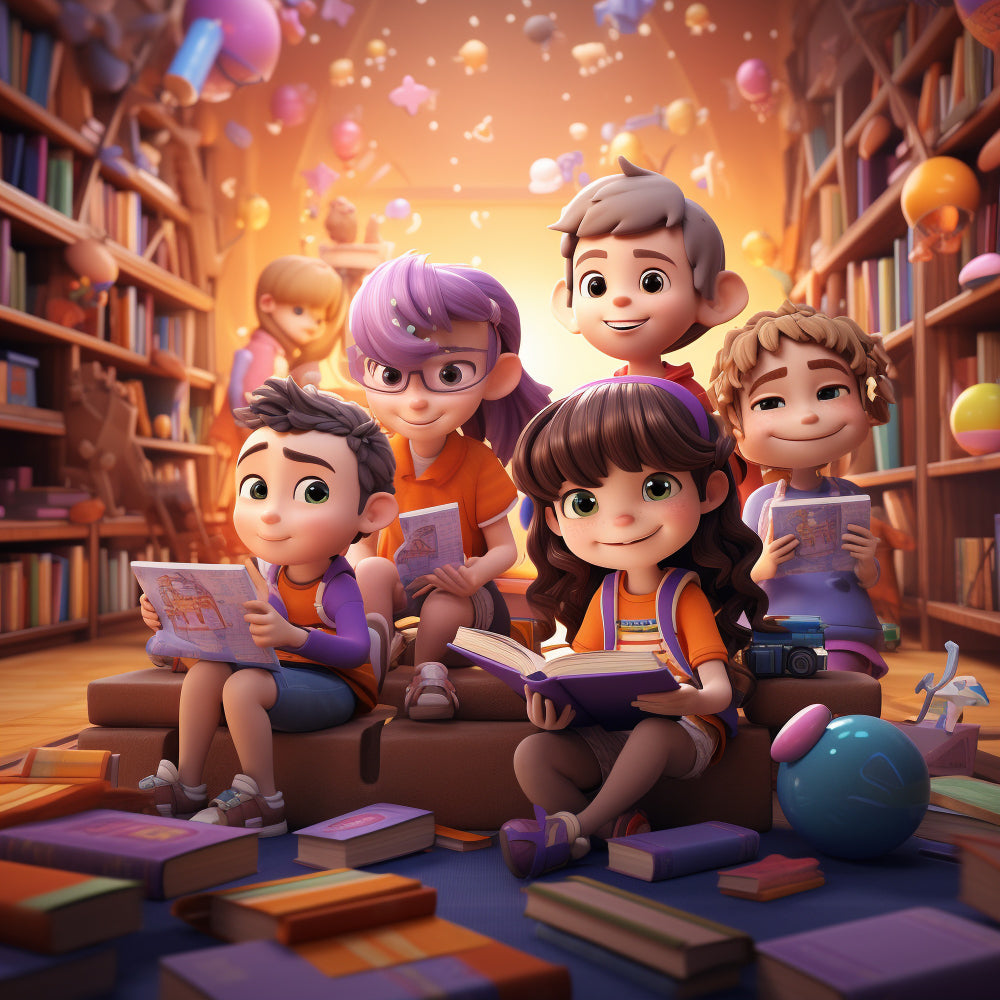Low Poly Character Design: Tips and Tricks

Ever wondered how those cool, blocky characters in your favorite video games come to life? Well, low poly character design is the secret sauce behind them, and it's come a long way! Imagine you're in a 3D video game and you meet the character who's about to take you on the adventure of a lifetime. That's low poly magic for you! These characters have this unique charm that hooks players instantly. It's like they've cracked the code of character design.
But what's the deal with low poly characters? Whether you're a 3D artist looking to refine your skills or a newcomer in the 3D world, this blog post is your guide to mastering the art and science of low poly character design.
I. The art and science behind the Low Poly Magic
A. What Is Low Poly Character Design?
At its core, low poly character design is an artistic approach that emphasizes simplicity through the use of a limited number of polygons or geometric shapes. These characters often possess a blocky or angular appearance, which sets them apart from their high poly counterparts. Low poly characters are celebrated for their ability to convey character and emotion with minimalism.
B. The Rising Trend of Low Poly Characters
In recent years, there has been an undeniable surge in the popularity of low poly characters across various creative industries. From the immersive realms of gaming to the enchanting worlds of animation and even the tangible realm of 3D printing, low poly characters have carved out a unique space for themselves. Their clean lines, polygonal aesthetics, and ability to convey complex emotions through simplicity have made them sought after by creators and adored by audiences.
C. The Artistic and Technical Balance
Low poly character design requires a balance between artistic expression and technical precision. While the goal is to simplify, it is important to ensure that your character retains its identity and charm. Achieving this balance involves making thoughtful choices about the placement and distribution of polygons, as well as the creative use of textures and shading techniques.
II. The Toolbox: Essentials for Low Poly Character Design
When it comes to low poly character design, one software stands out as a versatile and accessible choice: Blender. Blender offers a comprehensive set of modeling and animation tools, making it an excellent companion for artists venturing into low poly design. Throughout this blog, we'll explore how to harness Blender's capabilities to create stunning low poly characters.
A robust computer setup is essential for a seamless low poly character design workflow. To achieve smooth 3D modeling and rendering, you'll need a powerful computer with a capable graphics card. Additionally, investing in a graphics tablet can greatly enhance your precision and efficiency when sculpting your characters. Having the right hardware ensures that your creative process is as smooth as possible.
III. Basics of Character Design Foundations
A. Principles of Character Design
So, before we get into the technical aspects of low poly character design, let's talk about the basics. Imagine you're building a house; you need a solid foundation, right? Well, character design is your foundation in the world of low poly art. Start by crafting a compelling concept that defines your character's personality, backstory, and role within your project. Strong concepts are the driving force behind memorable low poly characters.
B. Real-World Examples of Iconic Low Poly Characters
To truly grasp what makes low poly characters unforgettable, let's take a closer look at some real-world examples. Consider characters like "Toad" from Nintendo's Super Mario series or the iconic "Minecraft" character, Steve. Despite their blocky appearances, these characters have etched themselves into the annals of pop culture. They exemplify how effective design choices can leave an indelible mark on the audience. These characters are a testament to the power of simplicity and purposeful design in low poly character creation.

IV. Low Poly Character Design Techniques
A. Advanced Polygon Management for Low Poly Character Modeling
Creating low poly characters is an art that requires mastering efficient polygon management. Here are some advanced techniques to help you achieve a perfect balance between detail and simplicity:
Selective Detailing: Identify key areas of your character that require more detail and allocate polygons accordingly. Focus on the face, hands, and other expressive regions while keeping the rest of the body simpler.
LOD (Level of Detail): Implement different levels of detail for your character to optimize performance in real-time applications like games. Create simplified versions of your character for distant views, gradually increasing detail as the camera gets closer.
Retopology: Retopology, which involves recreating the character's geometry with clean, efficient topology. This process allows you to maintain control over the polygon count and structure.
Normal Mapping: Use normal maps to fake surface detail and depth without adding extra polygons. This technique is particularly useful for creating intricate textures on low poly models.
B. Step-by-Step Guide to Creating a Basic Low Poly Character
Let's embark on a journey to create a simple low poly character using Blender:
i. Conceptualize Your Character:
Start by sketching or visualizing your character's design. Define its features, personality, and purpose.
ii. Basic Shapes:
Begin modeling your character with basic shapes like cubes, cylinders, and spheres. These will form the foundation of your character.
iii. Polygon Extrusion:
Use Blender's extrusion tool to pull and push polygons to shape your character's body and limbs.
iv. Facial Features:
Add facial features by extruding and shaping polygons for the eyes, nose, and mouth.
Limbs and Accessories:
Create limbs, clothing, and accessories using the same extrusion techniques. Keep an eye on polygon count to maintain simplicity.
vi. UV Unwrapping:
Unwrap your character's geometry to prepare it for texturing. Ensure the UV layout is clean and efficient.
vii. Texture Painting:
Apply textures to your character using Blender's texture painting tools. Keep textures simple and stylized to match the low poly aesthetic.
viii. Rigging and Animation:
If you plan to animate your character, set up a basic armature (skeleton) and rig your character for movement.
ix. Testing and Refinement:
Test your character in different poses and scenes to ensure it works well in various contexts. Make any necessary adjustments to improve its appearance and functionality.
x. Export:
Finally, export your low poly character for use in your chosen platform, be it a game engine, animation software, or 3D printing software.
V. Blender Low Poly Mastery: Expert Tips from the Pros
A. Lesser-Known Blender Features for Low Poly Character Design
Blender is a treasure trove of features that can enhance your low poly character design workflow. Here are a few lesser-known gems:
Sculpt Mode: Use Blender's Sculpt Mode to add finer details to your low poly character. It's a tool for refining facial expressions and adding subtle imperfections.
Proportional Editing: Enable Proportional Editing to make complex shape adjustments with ease. It allows you to influence multiple vertices simultaneously while maintaining natural deformations.
Edge Flow: Pay attention to your character's edge flow, ensuring that loops and geometry follow the contours of the character smoothly. This helps with animation and deformation.
Shape Keys: Utilize shape keys to create different facial expressions and poses without rigging. Shape keys are incredibly useful for stylized character animation.
B. Insights from Experienced Blender Artists
We've gathered insights from seasoned Blender artists who have mastered the art of low poly character design:
Workflow Efficiency: Experienced artists emphasize the importance of an organized workflow. Create custom hotkeys, presets, and templates to streamline your process.
Texture Mapping Tricks: Utilize Blender's UV mapping tools effectively. Learning how to pack UV islands efficiently can save space and improve texture resolution.
Materials and Shading: Experiment with Blender's material nodes to achieve unique shading effects. Don't be afraid to mix shaders and textures for a distinct look.
Community and Learning: Engage with the Blender community and online tutorials. There's a wealth of knowledge available, and staying connected with fellow artists can inspire growth.
VI. From High Poly to Low Poly: Converting High Poly Models to Low Poly Versions
Now, let's tackle a rather complex aspect of low poly character design: the transformation from high poly to low poly. Picture this as sculpting a masterpiece from a massive block of marble. It's intricate work, but the result is a sleek, minimalist version of your character.
Converting high poly models into low poly versions can be quite a challenge. You're faced with the task of reducing polygon counts while simplifying intricate details and, most importantly, preserving the character's essence. It's a bit like trimming a bonsai tree - you need to remove the excess while maintaining the core beauty.
This process often requires a blend of manual modeling and automated optimization tools. Think of it as a delicate dance between your artistic skills and the power of technology, all aimed at achieving that perfect low poly aesthetic.

VII. Breathing Life into Low Poly Characters: Animation Essentials
A. The Nuances of Character Animation in Low Poly
Now, let's explore the art of animating low poly characters, which requires a distinctive approach. It's like painting a vivid picture with a limited color palette – you need to make every stroke count.
Animating these characters is all about embracing exaggeration. Think bold, expressive movements and facial expressions that convey emotions and actions effectively. With limited geometry to work with, every polygon plays a crucial role in expressing your character's personality and advancing the storyline. It's akin to conveying a complex narrative through the elegant simplicity of a haiku.
B. Tips for Rigging and Animating Effectively
To breathe life into your low poly creation, here are some invaluable tips for rigging and animation:
Simplify Rigs: Keep your character's rig simple and efficient to maintain the low poly aesthetic. Avoid unnecessary bones and complexity that might clutter your character's structure. Think of it as streamlining your character's puppet strings for a smooth performance.
Stylized Animation: Low poly characters shine with stylized animation techniques that complement their simplicity. Bold poses and expressive actions are your allies in this context. Imagine your character as a charismatic actor on a minimalist stage, where every movement conveys meaning.
Keyframe Control: When it comes to animation, precision is your best friend. Utilize keyframe animation to define your character's movements with exactitude. Pay keen attention to timing and spacing, as they are the secret ingredients that transform motion into believability. It's like orchestrating a symphony, where each note has a specific place and purpose.
These tips can unlock the full potential of your low poly characters, infusing them with life and personality. It's an art form where every movement is a brushstroke, and every frame tells a story, all within the elegant constraints of low poly design.
VIII. 3D Printing Adventures: Crafting Physical Low Poly Characters
A. Design Considerations for 3D Printing Low Poly Characters
When it comes to bringing your low poly characters into the physical realm through 3D printing, there are specific considerations to keep in mind:
Solid Geometry: Ensure that your character's geometry is watertight and free from errors. 3D printers require models with solid geometry to accurately replicate your design.
Printability: Optimize your model for 3D printing by minimizing overhangs and adding support structures where needed. This step ensures that your character can be successfully printed without structural issues.
B. Post-Processing Techniques
Once your low poly character emerges from the 3D printer, post-processing techniques can take your creation to the next level. Consider these methods to enhance the final results:
Sanding: Smoothing the surface of your 3D-printed character with sandpaper can eliminate layer lines and create a more polished appearance.
Painting: Adding a layer of paint can bring color and vibrancy to your physical low poly character, allowing you to customize its appearance further.
Varnishes: Applying varnishes or clear coatings can provide protection and give your character a glossy finish, enhancing its overall aesthetic.

Conclusion: Crafting Low Poly Masterpieces
Low poly character design is more than just a trend; it's a timeless art form that continues to shape contemporary 3D artistry. These characters, with their distinctive charm and storytelling potential, have created a special place in various industries, including gaming, animation, and 3D printing. Whether you're crafting characters for a blockbuster video game, an animated film, or even for 3D printing, low poly design offers a canvas where your imagination knows no bounds. And if you ever find yourself in need of expert assistance, don't forget that my3dmodels.com stands ready to bring your low poly character visions to life. They specialize in creating low poly characters tailored to the unique needs of any industry.
-
Posted in
3d character modeling, 3d game, 3d modeling, low poly




